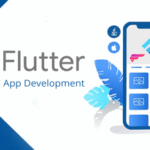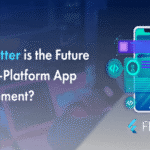Mobile AppTop Mobile App Development Trends to Watch in 2025

The mobile app development landscape is evolving rapidly, driven by technological advancements, consumer demands, and business innovation. As we step into 2025, staying ahead of the curve means understanding and embracing the latest trends shaping this industry. This blog explores the top mobile app development trends to watch in 2025 and how they will redefine user experiences, app functionalities, and market strategies.
Table of Contents
Introduction to Mobile App Trends in 2025
The mobile app industry is expected to surpass $1 trillion in revenue by 2025, making it one of the fastest-growing sectors globally. Emerging technologies like AI, blockchain, and AR/VR are reshaping the development process, offering developers unprecedented opportunities to innovate. This dynamic environment requires businesses to stay informed and agile to meet evolving user expectations.
Key Mobile App Development Statistics for 2025
- Global App Downloads: Projected to exceed 300 billion annually.
- Revenue Growth: Expected to grow at a CAGR of 12%, driven by in-app purchases, subscriptions, and ads.
- 5G Adoption: Over 60% of global mobile users will have access to 5G by the end of 2025, enabling faster and more immersive app experiences.
Top Trends in Mobile App Development
1. AI-Driven Mobile Apps
AI continues to revolutionize mobile app functionality, enabling personalized experiences, predictive analytics, and intelligent automation. Popular applications include:
- Chatbots: Offering 24/7 support and enhancing customer service.
- AI Recommendations: For e-commerce and content platforms, improving engagement.
- Generative AI: Enabling real-time content creation for users.
Example Use Case: Spotify’s AI-driven recommendations increase user retention by delivering tailored playlists.
2. Low-Code and No-Code Development Platforms
Low-code and no-code platforms empower businesses and non-developers to create apps efficiently. These platforms reduce development time and costs, making app creation more accessible.
Benefits:
- Accelerated time-to-market.
- Reduced dependency on traditional coding.
- Simplified integration with APIs and third-party services.
3. Super Apps
Super apps, popularized by platforms like WeChat, offer users multiple functionalities within a single app. In 2025, more businesses are likely to adopt this trend to enhance user engagement and convenience.
Features:
- Payment gateways.
- E-commerce integrations.
- Social networking capabilities.
Example: Grab in Southeast Asia combines ride-hailing, food delivery, and payments.
4. 5G-Enhanced Experiences
5G technology is transforming app capabilities with faster download speeds, lower latency, and enhanced connectivity. Developers can create more immersive experiences, especially for AR, VR, and real-time apps.
Use Cases:
- Live-streaming in ultra-HD.
- Real-time multiplayer gaming.
- IoT device management.
5. Augmented and Virtual Reality (AR/VR)
AR/VR technologies are becoming mainstream, offering innovative solutions in gaming, education, and retail. AR-enabled apps allow users to interact with their surroundings, while VR creates fully immersive environments.
Examples:
- AR in retail: Virtual try-ons for clothing and accessories.
- VR in education: Simulated training environments.
6. Blockchain for Enhanced Security
Blockchain technology ensures app security by encrypting user data and transactions. It’s particularly impactful for fintech, healthcare, and supply chain apps.
Applications:
- Secure payment systems.
- Transparent supply chain tracking.
- Decentralized identity management.
7. Wearable Technology Integration
Wearable devices like smartwatches and fitness trackers are driving demand for apps that integrate seamlessly with these gadgets. Features like health monitoring, real-time notifications, and IoT connectivity are gaining traction.
Trends in Wearable Apps:
- Remote health monitoring.
- Biometric data analysis.
- Enhanced fitness tracking.
8. Voice Technology and Conversational Interfaces
Voice assistants like Siri, Alexa, and Google Assistant are becoming more sophisticated. Voice-enabled apps enhance accessibility and cater to the growing demand for hands-free operation.
Voice Technology Use Cases:
- Voice search for e-commerce apps.
- Smart home integrations.
- Voice-controlled gaming.
How Businesses Can Leverage These Trends
- Invest in R&D: Allocate resources to explore emerging technologies like AI, blockchain, and AR/VR.
- Partner with Experts: Collaborate with app development companies to implement innovative solutions effectively.
- Focus on User Experience: Ensure apps are intuitive, responsive, and engaging.
- Adopt Agile Methodologies: Stay flexible and adapt quickly to changing market demands.
Conclusion
Mobile app development in 2025 is set to be transformative, driven by cutting-edge technologies and innovative approaches. Businesses that stay ahead of these trends will not only enhance their app offerings but also establish themselves as industry leaders. Whether it’s leveraging AI, integrating AR/VR, or embracing blockchain, the opportunities are endless.
FAQs on Mobile App Trends
01. What is the future of AI in mobile apps?
AI will continue to enhance mobile apps by providing personalized experiences, automating processes, and improving decision-making through predictive analytics.
02. Why are super apps gaining popularity?
Super apps combine multiple functionalities, making them convenient for users and increasing engagement for businesses.
03. How does 5G impact app development?
5G enables faster and more reliable connectivity, supporting advanced features like real-time streaming, IoT integration, and immersive AR/VR experiences.
Case Studies:
1. AI-Driven Mobile Apps
AI is revolutionizing mobile app development, enabling businesses to provide hyper-personalized experiences, automate operations, and leverage predictive analytics.
Detailed Case Study: AI-Powered Health Coaching App
- Client Name: Confidential (Signed NDA)
- Industry: Health and Wellness
- Objective: The client wanted to create an app that offered personalized fitness plans, nutrition advice, and mental health coaching, tailored to each user’s unique requirements.
- Challenges:
- Developing an AI model capable of analyzing user behavior, biometric data, and preferences.
- Ensuring HIPAA compliance for data security.
- Seamlessly integrating third-party wearable devices for real-time data synchronization.
- Our Approach:
- AI Integration: We built a custom machine learning algorithm that analyzed user-provided data, such as age, activity levels, and dietary habits, to recommend personalized plans.
- Real-Time Analytics: Leveraged APIs to sync with wearable devices like Fitbit and Apple Watch, providing users with live feedback on their progress.
- Data Security: Incorporated end-to-end encryption and biometric authentication to ensure user data safety.
- Results:
- Achieved a 70% increase in app engagement rates due to personalized features.
- Reduced user attrition by 40%, as users reported higher satisfaction levels.
- Garnered over 500,000 downloads within six months of launch.
- Technologies Used: TensorFlow for AI modeling, Node.js for backend development, and AWS for secure data storage.
2. Blockchain for Enhanced Security
Blockchain technology ensures transparency, immutability, and security in mobile applications, making it ideal for industries like fintech, healthcare, and logistics.
Detailed Case Study: Blockchain-Based Payment Gateway
- Client Name: Confidential (Signed NDA)
- Industry: Fintech
- Objective: The client required a blockchain-powered app to process secure, peer-to-peer financial transactions while reducing dependency on third-party payment processors.
- Challenges:
- Designing a scalable blockchain network to handle high transaction volumes.
- Ensuring low latency for near-instantaneous transaction approvals.
- Implementing multi-currency support for global users.
- Our Approach:
- Private Blockchain Development: Built a Hyperledger-based private blockchain to process transactions securely and efficiently.
- Smart Contracts: Developed smart contracts to automate transaction validations, reducing manual intervention.
- User-Friendly Interface: Designed an intuitive app interface that simplified cryptocurrency transactions for users unfamiliar with blockchain technology.
- Results:
- Processed over $2 billion in transactions within the first year of operation.
- Achieved a 99.9% success rate for transactions with negligible downtime.
- Increased user trust due to transparent transaction tracking.
- Technologies Used: Hyperledger Fabric, Solidity for smart contracts, and React Native for a seamless cross-platform experience.
Call-to-Action: Want to Explore More Success Stories?
We’ve successfully partnered with businesses across industries to create impactful mobile solutions. To learn more about our innovative projects, Contact Us Today and discover how we can turn your vision into reality.




